Topics
Category
Era
Civilian Conservation Corps in Minnesota, 1933–1942
Civilian Conservation Corps workers building a road near Roosevelt, Minnesota, ca. 1933. Photographed by J. A.Gjelhaug.
The U.S. Congress paved the way for the Civilian Conservation Corps (CCC) when it passed the Emergency Conservation Work (ECW) Act in March 1933, at the height of the Great Depression. This New Deal program offered meaningful work to young men with few employment prospects. It resulted in a lasting legacy of forestry, soil, and water conservation, as well as enhancements to Minnesota's state and national parks.
Like other government programs launched during the Great Depression, the CCC was the brainchild of President Franklin Delano Roosevelt (FDR). Five days after Congress passed the ECW Act, he signed Executive Order 6101, creating the CCC.
Several federal agencies had responsibility for the CCC program. The Labor Department handled recruitment. The War Department managed camp organization, induction, housing, food, and clothing. Army personnel supervised the camps. The Departments of Agriculture and Interior developed the work projects.
The government set a nationwide quota of 250,000 young men ages eighteen to twenty-five. To qualify, candidates had to be healthy U.S. citizens, out of school, unemployed, unmarried, and on public assistance. Recruits reported to an assigned camp for a period of six months. Those with a good work record had the option to sign up for a second six-month term. Each man received thirty dollars per month. Enrollees were required to send twenty-five dollars home to their families, and kept five dollars for personal use.
The CCC program permitted African American men to enroll, but it became harder for blacks to be accepted into the program as white enrollment increased. According to historian Barbara W. Sommer, African Americans made up only about 10 percent of all recruits. Once enrolled, they found that the camps followed the U.S. Army's racist segregation policies. Most black men served in all-African American camps at such locations as Fort Snelling State Park and Temperance River State Park. Those sent to white camps lived in segregated barracks and ate their meals apart from the rest of the recruits.
Blacks in the CCC faced discrimination from local citizens and from some white camp commanders. Ignoring the program's integration requirements, administrators stopped accepting blacks into Minnesota camps in 1938. They sent those already enrolled to camps in Missouri and other southern locations where Jim Crow laws were common, despite protests from the African American community in Minnesota.
In April 1933, the government extended enrollment to older men known as Local Experienced Men. These men had useful knowledge of camp locations and offered more advanced skills for tasks such as stone masonry and forestry than their younger colleagues. The large number of unemployed veterans of World War I prompted FDR to further expand the CCC program. He created the Veterans Conservation Corps in May 1933 with an enrollment goal of twenty-five thousand men.
On June 19, 1933, the Office of Indian Affairs within the Department of the Interior established the Civilian Conservation Corps-Indian Division (CCC-ID). Based on Minnesota's Native American population, the government set a quota of four hundred workers for each enrollment period in the program. In less than one month, Minnesota's first CCC-ID camp opened at Nett Lake.
The Bureau of Indian Affairs administered the CCC-ID camps, instead of the U.S. Army, and provided work projects both on and off the reservations. In line with the Indian Reorganization Act of 1934, many CCC-ID projects focused on preservation of Ojibwe and Dakota culture, including management of wild rice habitat and teaching modern methods of maple sugaring. These men also built roads and cleared diseased trees in local forests. The Grand Portage camp completed an archaeological study and reconstruction of the North West Company Fur Post historic site on Lake Superior. The result is one of the best-known examples of CCC-ID work.
Minnesota's camps were located in the Seventh U.S. Army Corps Area. This area included the Dakotas, Nebraska, Iowa, Missouri, Kansas, and Arkansas. Based on the state's population, Minnesota was to have sixty-one camps with a total enrollment of six thousand men. The first Minnesota camp, Company 701, opened at Lake Gegoka (near Isabella) on May 8, 1933. Other camps quickly followed, including the first state forest and state park camps.
Each camp had barracks to house two hundred men, a kitchen, a mess hall, and a camp canteen that sold personal items. Other camp structures included tool sheds, an infirmary, a reading room, and a recreation hall. A typical work day was eight hours, starting at 6:00 a.m. with exercises and breakfast. Morning and afternoon work sessions allowed for breaks for lunch and supper, with the noon meal sometimes served at the work site if it was located too far from camp. Evening hours provided free time for recreation and study, with lights out at 9:30 p.m. Many camps offered vocational training programs and church services. The men could join organized sports teams and play card games or billiards as leisure time activities.
Minnesota CCC projects centered mainly on forestry and state and national park projects. They also supported soil and water conservation. The men in forest camps cut and cleared brush to help conserve existing forests and planted 123,607,000 trees. They participated in tree disease prevention programs, built roads, strung telephone lines, and fought forest fires. Fire prevention efforts included clearing deadwood and building water towers, ranger stations, and firebreaks.
Park projects focused on the building of permanent "rustic style" structures of local stone and logs following National Park Service guidelines. The CCC built and improved camp grounds, picnic areas, parking lots, and scenic overlooks. They worked to restore historic structures, such as the commissary building at the Fort Ridgely historic site.
Severe drought conditions in the mid-1930s, particularly in southeastern Minnesota, made soil and water conservation an important part of the work of the CCC. The enrollment quota increased to 350,000 in 1934, and to six hundred thousand the next year, to meet the program's needs. The CCC planted windbreaks, built dams, dug drainage ditches and put up fencing. Working with local farmers, they created custom plans for each farm incorporating modern farming methods such as terracing, contour farming, and strip cropping.
The accomplishments of the men of the CCC are evident throughout the state. Examples of rustic-style structures, many on the National Register of Historic Places, still stand in Minnesota state parks. The trees planted have revitalized Minnesota's forests. Soil conservation measures adopted in the 1930s resulted in the passage of the 1937 Soil and Water Conservation Districts Law. Under this law, Minnesota farmers continue to use the methods promoted by the CCC to prevent soil erosion, water conservation, and flooding.
The CCC program peaked in Minnesota in 1935 with 104 active camps. Enrollment nationwide began to decline in the early 1940s as young men joined the military for World War II and as the economy began to rebound. Despite efforts to make the CCC permanent, funding for the program ended on June 30, 1943. All of Minnesota's camps closed in 1942. More than seventy-seven thousand Minnesota men found employment with the program. The CCC-ID program assisted more than twenty-five hundred Native American families in the state. The young men of the CCC credited the program with teaching self-discipline and leadership, instilling confidence and self-respect, and helping them to develop useful career skills.
Bibliography
Author's note: Hard Work and a Good Deal: the Civilian Conservation Corps in Minnesota was the main source used in the writing of this article.
Benson, David R. Stories in Log and Stone: the Legacy of the New Deal in Minnesota State Parks. St. Paul: Minnesota Department of Natural Resources, 2002.
Civilian Conservation Corps, Camp F-53, Handbook of Instruction for Enrollees. Two Harbors, MN: The Company, 1939.
Dearborn, Ned H. Once in a Lifetime: a Guide to the CCC Camp. New York: Charles E. Merrill, 1936.
Harby, Samuel Farkas. A Study of Education in the Civilian Conservation Corps Camps of the Second Corps Area, April 1933–March 1937. Ann Arbor, MI: Edwards Bros., 1938.
Gower, Calvin W. "The CCC Indian Division: Aid for Depressed Americans, 1933–1942." Minnesota History 43, no. 1 (Spring 1972): 3–13. http://collections.mnhs.org/MNHistoryMagazine/articles/43/v43i01p003-013.pdf
Hoyt, Ray. "Your CCC": a Handbook for Enrollees. Washington, DC: Happy Days Publishing Company, [1938?].
Johnson, Frederick K. "The Civilian Conservation Corps: a New Deal for Youth." Minnesota History 48, no. 7 (Fall 1983): 295–302.
http://collections.mnhs.org/MNHistoryMagazine/articles/48/v48i07p295-302.pdf
Meyer, Roy W. Everyone's Country Estate: A History of Minnesota's State Parks. St. Paul: Minnesota Historical Society Press, 1991.
Minnesota Historical Society. Itasca State Park: Descriptions of Selected Resources. http://www.mnhs.org/places/nationalregister/stateparks/ItascaRes.php
SD143
Pamphlets Relating to the Civilian Conservation Corps in Minnesota, 1933–
Pamphlet Collection, Minnesota Historical Society, St. Paul
Description: Pamphlets and printed ephemera relating to the history of the Civilian Conservation Corps in Minnesota and the U.S., individual camps in Minnesota, camp reunions, handbooks, and other materials.
Sommer, Barbara W. Hard Work and a Good Deal: the Civilian Conservation Corps in Minnesota. St. Paul: Minnesota Historical Society Press, 2008.
Sommer, Barbara W. "'We Had This Opportunity': African Americans and the Civilian Conservation Corps in Minnesota." In The State We're In: Reflections on Minnesota History, edited by Annette Atkins and Deborah L. Miller, 134–157. St. Paul: Minnesota Historical Society Press, 2010.
United States Soil Conservation Service. The CCC at Work: A Story of 2,500,000 Young Men. Washington: U.S. Government Printing Office, 1941.
Wirth, Conrad Louis. Civilian Conservation Corps: Program of the United States Department of the Interior, March 1933 to June 30, 1943; A Report to Harold L. Ickes, Secretary of the Interior. Washington, DC: U.S. Government Printing Office, 1944.
Related Resources
Primary
CCC Camp Work Plan, Camp SCS-MN-21, Fergus Falls, Minnesota. Typescript. 1941.
G 4141 .G3 1934 .C58
C.C.C. Camps in Minnesota. [United States: N.p., 1934?].
Map Collection, Minnesota Historical Society, St. Paul
http://collections.mnhs.org/cms/display.php?irn=10473687
Description: C.C.C. Camps in Minnesota/Minnesota District.
Album 35
Civilian Conservation Corps camp 712, Grand Marais photography album, 1940
Sound and Visual Collection, Minnesota Historical Society, St. Paul
Description: Views of camp buildings, staff, activities, work projects, and scenic views of the area.
http://www2.mnhs.org/library/findaids/sv000352.xml
Album 36
Minnesota District Civilian Conservation Corps camps, photography album 1935–1938
Sound and Visual Collection, Minnesota Historical Society, St. Paul
Description: Views of officers and personnel, camp buildings and facilities, work projects and equipment.
http://www2.mnhs.org/library/findaids/sv000353.xml
2007.112.14
3D Objects Collection, Minnesota Historical Society, St. Paul
http://collections.mnhs.org/cms/display.php?irn=10574660
CCC Form Letter issued by the Civilian Conservation Corps Company 3702, Camp Luna Lake, Federal Forest Camp F-25, July 17, 1938.
M2051
Civilian Conservation Corps Camp Papers
Newspaper Collection, Minnesota Historical Society, St. Paul
Description: Issues of camp newspapers from Minnesota Civilian Conservation Corps camps.
Kylie, Harry Raymond. CCC Forestry. Washington, D.C.: U.S. Government Publishing Office, 1937.
P2593
CCC Training Notebook, 1939–1941
Manuscript Collection, Minnesota Historical Society, St. Paul
Description: A loose-leaf notebook kept by Norton A. Ross, a student, instructor, and employee of Civilian Conservation Corps Company 4707 at Outing (Cass County), Minnesota; contains notes and administrative documents, and pencil drawings.
OH 14 and OH 15
Civilian Conservation Corps Oral History Project, 1976
Oral History Collection, Minnesota Historical Society, St. Paul
http://collections.mnhs.org/cms/display?irn=10445985
http://collections.mnhs.org/cms/display?irn=10445987
Description: Two members of the Civilian Conservation Corps in Minnesota in the 1930s are interviewed about their time in the CCC, including camp life, corps work, and fellow corps workers.
OH 102
Oral History Interviews of the Itasca State Park Oral History Project, 1993–1994, 2000
Oral History Collection, Minnesota Historical Society, St. Paul
http://collections.mnhs.org/cms/display.php?irn=10469059
Description: Twenty-seven oral history interviews with people who had associations with Itasca State Park.
OH 118
Oral History Interviews of the Minnesota's Greatest Generation Oral History Project: Minnesota Native American Interviews, 2006
Oral History Collection, Minnesota Historical Society, St. Paul
http://collections.mnhs.org/cms/display?irn=10606952
Description: Interviews with Minnesota Native Americans who lived during the Great Depression and World War II. Subjects include Civilian Conservation Corps (CCC), Works Progress Administration, military service, and post-war experiences. Total length: 27 hours 16 minutes.
Summary, Minnesota CCC Work, 1933–1941. [Grand Rapids?], MN: The Corps and Minnesota Department of Conservation, [1941?].
Secondary
Nelson, Edward P., and Barbara Sommer, eds. It Was a Good Deal: the Civilian Conservation Corps in Northeastern Minnesota; a Guide to the Arrowhead Civilian Conservation Corps Documentation Project. Duluth, MN: St. Louis County Historical Society, 1987.
Web
2007.112.14
3D Objects Collection, Minnesota Historical Society, St. Paul
http://collections.mnhs.org/cms/display.php?irn=10574660
Description: Civilian Conservation Corps form letter describing camp life and the duties of a recruit, 1938.
Civilian Conservation Corps Legacy. CCC Camps Minnesota.
http://www.ccclegacy.org/CCC_Camps_Minnesota.html
Minnesota Department of Natural Resources. State Parks and Recreation Areas.
http://www.dnr.state.mn.us/state_parks/index.html
Minnesota Digital Library. Civilian Conservation Corps in Minnesota.
http://mndigital.org/projects/primary-source-sets/civilian-conservation-corps-minnesota
National Park Service. Grand Portage National Monument.
https://www.nps.gov/grpo/index.htm
University of California, Santa Barbara. The American Presidency Project: Franklin D. Roosevelt.
https://www.presidency.ucsb.edu/people/president/franklin-d-roosevelt
WTIP North Shore Community Radio. The Legacy of the Civilian Conservation Corps.
http://www.wtip.org/content/legacy-civilian-conservation-corps-0
Related Video
Civilian Conservation Corps - 75th anniversary
The month of March 2008 marked the 75th anniversary of the Civilian Conservation Corps, established March 31, 1933. Curator Matt Anderson commemorates the occasion with a look at CCC pieces in the Minnesota Historical Societys collection.
Holding Location
More Information
Related Images
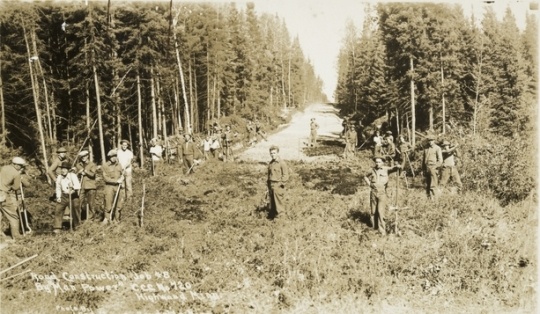
Civilian Conservation Corps workers building a road
Civilian Conservation Corps workers building a road near Roosevelt, Minnesota, ca. 1933. Photographed by J. A.Gjelhaug.
Holding Location
More Information

Civilian Conservation Corps, Company 1753
Civilian Conservation Corps, Company 1753, Elba, 1933. Photographed by George O. Mehl.
Holding Location
More Information

African American CCC Company 1728
African American CCC Company 1728, Camp Temperance F-19, Tofte, 1934.
Holding Location
More Information
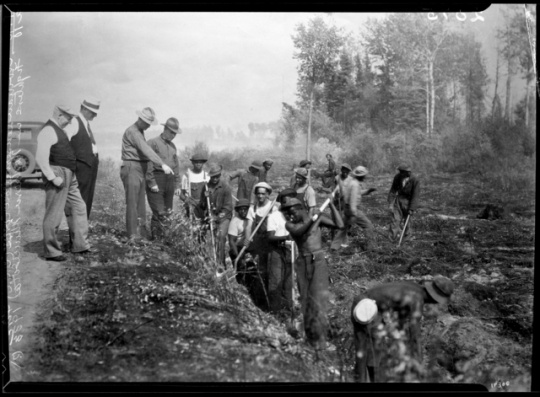
African American Civilian Conservation Corps fire fighters
African American Civilian Conservation Corps fire fighters, northern Minnesota, ca. 1933. Photographed by the St. Paul Dispatch.
Holding Location
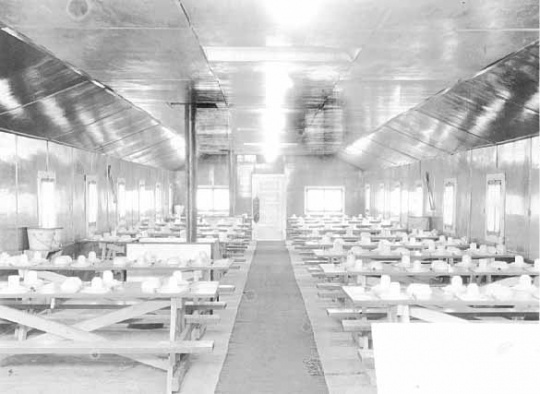
Camp dining hall
Camp dining hall, Company 707, Civilian Conservation Corps camp at Deer River, ca. 1936.
Holding Location
More Information
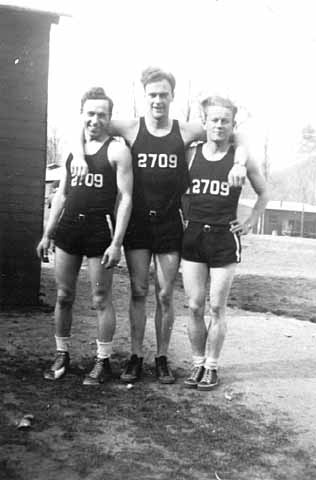
Basketball players, Civilian Conservation Corps Company 2709
Basketball players, Civilian Conservation Corps Company 2709, Whitewater State Park. Left to right: Joe Lewis, Frederick K. Johnson, and Carl Lund, 1935.
Holding Location
More Information
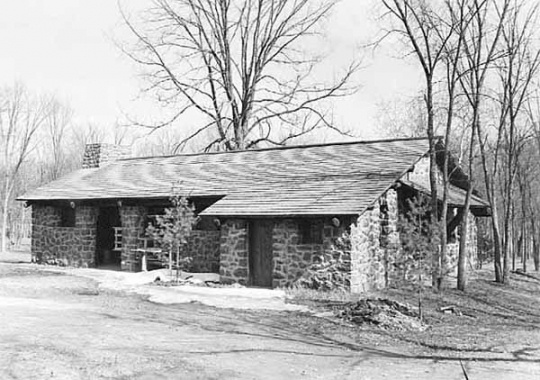
Park building, Interstate State Park
Park building, Interstate State Park, ca. 1936.
Holding Location
More Information
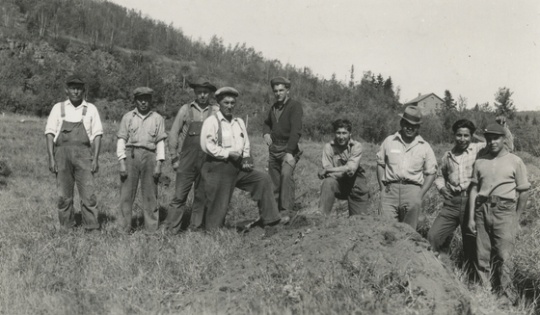
Indian Civilian Conservation Corps crew
Indian Civilian Conservation Corps crew on the stockade site at the end of the first day of work, Grand Portage, Minnesota, 1937. Photographed by Willoughby Maynard Babcock, Jr.
Holding Location
More Information

Construction of a stone building Gooseberry Falls
Construction of a stone building by CCC Company 2710, Gooseberry Falls, ca. 1938.
Holding Location
More Information
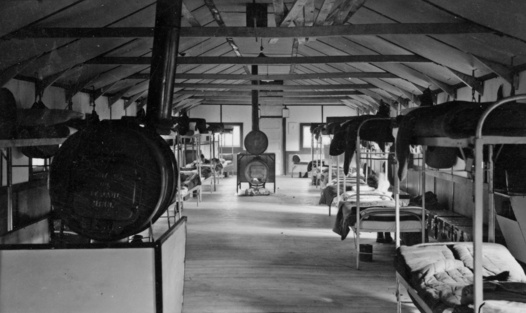
Barracks at the Cut Foot Sioux camp
Barracks at the Cut Foot Sioux camp, F-14, CCC Company 707 at Dear River, ca. 1938.
Holding Location
More Information
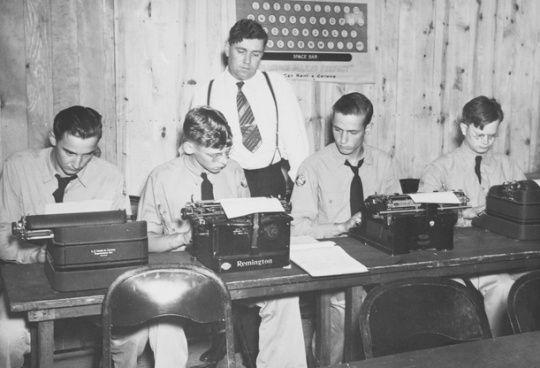
Adult education program
Adult education program at the Civilian Conservation Corps camp at Maple Lake, ca. 1938.
Holding Location
More Information
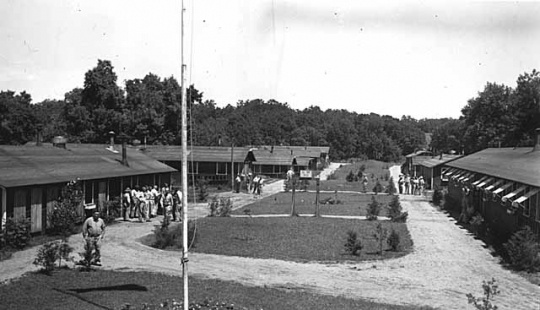
Civilian Conservation Corps camp, Sibley State Park
Civilian Conservation Corps camp, Sibley State Park, ca. 1930s.
Holding Location
More Information
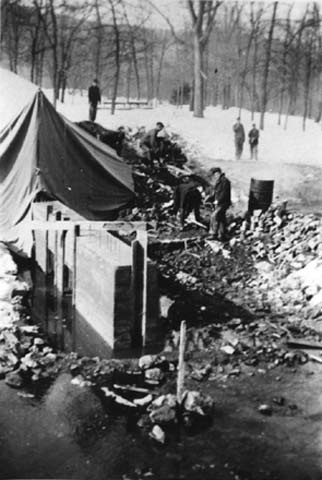
Workers at the Whitewater State Park CCC camp
Workers at the Whitewater State Park CCC camp, ca. 1930s.
Holding Location
More Information

Cabin in Itasca State Park
Cabin in Itasca State Park built by the Civilian Conservation Corps, ca. 1940.
Holding Location
More Information
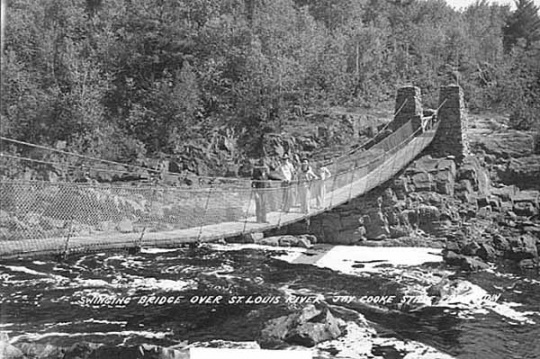
Swinging bridge over St. Louis River, Jay Cooke State Park
1939 swinging bridge over St. Louis River, Jay Cooke State Park, ca. 1950.
Holding Location
More Information

Civilian Conservation Corps shirt
Civilian Conservation Corps shirt worn by Fred Fretheim of CCC Company 3707, Two Harbors, Minnesota, ca. 1936–1937.
All rights reserved
Holding Location
More Information
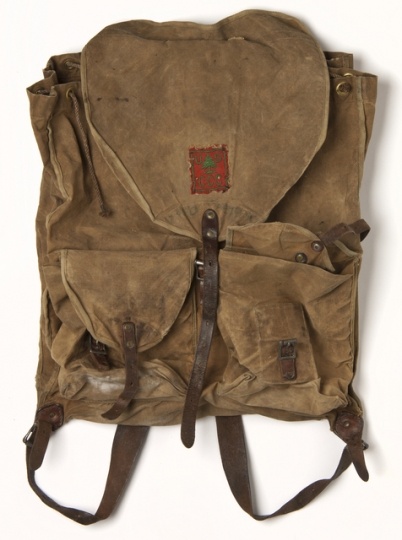
Conservation Corps knapsack
Conservation Corps knapsack used by Fred Fretheim, CCC Company 3707, Two Harbors, Minnesota, ca. 1936–1937.
All rights reserved
Holding Location
More Information
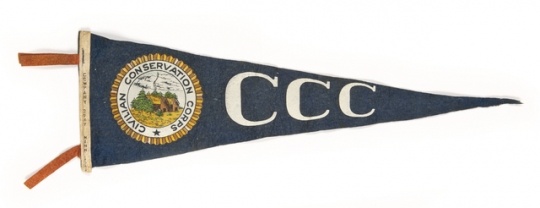
Civilian Conservation Corps pennant
Civilian Conservation Corps pennant owned by Fred Fretheim, ca. 1936–1937. Hand printed on the hoist edge is "company 2707/Minn/1936-7."
All rights reserved
Holding Location
More Information
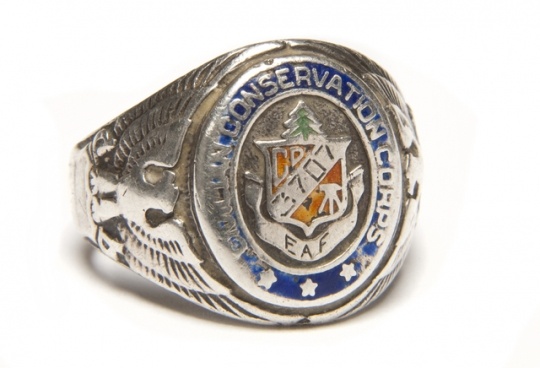
Sterling silver Civilian Conservation Corps ring
Sterling silver Civilian Conservation Corps ring with CCC logo flanked by an eagle and shield on opposing ends. Logo is engraved with "3707/ and "EAF". Worn by Fred Fretheim of Company 3707, Two Harbors, MN, ca. 1936–1937.
All rights reserved
Holding Location
More Information
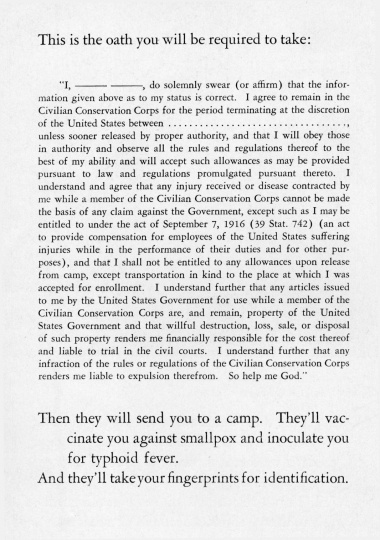
CCC Oath
CCC Oath, from The CCC at work. A story of 2,500,000 young men, 1941.
Holding Location
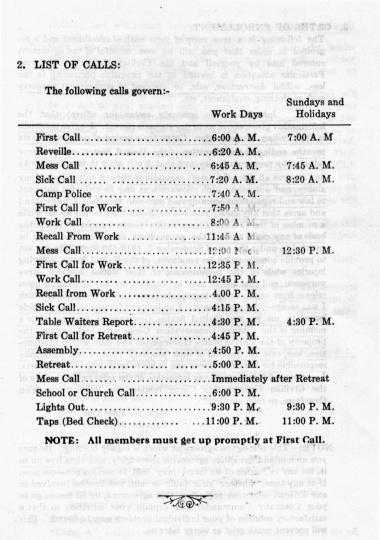
Daily CCC camp schedule
Daily CCC camp schedule from Handbook of instruction for enrollees, 1939.
Holding Location
Related Articles
Turning Point
In 1935, enrollment in the CCC reaches its peak at 500,000 nationally and 18,500 in Minnesota.
Chronology
March 31, 1933
April 5, 1933
April 22, 1933
April 29, 1933
April 1933
May 11, 1933
June 1933
July 16, 1933
May 11, 1934
1934
1935
1937
1938
Summer 1942
July 10, 1943
Bibliography
Author's note: Hard Work and a Good Deal: the Civilian Conservation Corps in Minnesota was the main source used in the writing of this article.
Benson, David R. Stories in Log and Stone: the Legacy of the New Deal in Minnesota State Parks. St. Paul: Minnesota Department of Natural Resources, 2002.
Civilian Conservation Corps, Camp F-53, Handbook of Instruction for Enrollees. Two Harbors, MN: The Company, 1939.
Dearborn, Ned H. Once in a Lifetime: a Guide to the CCC Camp. New York: Charles E. Merrill, 1936.
Harby, Samuel Farkas. A Study of Education in the Civilian Conservation Corps Camps of the Second Corps Area, April 1933–March 1937. Ann Arbor, MI: Edwards Bros., 1938.
Gower, Calvin W. "The CCC Indian Division: Aid for Depressed Americans, 1933–1942." Minnesota History 43, no. 1 (Spring 1972): 3–13. http://collections.mnhs.org/MNHistoryMagazine/articles/43/v43i01p003-013.pdf
Hoyt, Ray. "Your CCC": a Handbook for Enrollees. Washington, DC: Happy Days Publishing Company, [1938?].
Johnson, Frederick K. "The Civilian Conservation Corps: a New Deal for Youth." Minnesota History 48, no. 7 (Fall 1983): 295–302.
http://collections.mnhs.org/MNHistoryMagazine/articles/48/v48i07p295-302.pdf
Meyer, Roy W. Everyone's Country Estate: A History of Minnesota's State Parks. St. Paul: Minnesota Historical Society Press, 1991.
Minnesota Historical Society. Itasca State Park: Descriptions of Selected Resources. http://www.mnhs.org/places/nationalregister/stateparks/ItascaRes.php
SD143
Pamphlets Relating to the Civilian Conservation Corps in Minnesota, 1933–
Pamphlet Collection, Minnesota Historical Society, St. Paul
Description: Pamphlets and printed ephemera relating to the history of the Civilian Conservation Corps in Minnesota and the U.S., individual camps in Minnesota, camp reunions, handbooks, and other materials.
Sommer, Barbara W. Hard Work and a Good Deal: the Civilian Conservation Corps in Minnesota. St. Paul: Minnesota Historical Society Press, 2008.
Sommer, Barbara W. "'We Had This Opportunity': African Americans and the Civilian Conservation Corps in Minnesota." In The State We're In: Reflections on Minnesota History, edited by Annette Atkins and Deborah L. Miller, 134–157. St. Paul: Minnesota Historical Society Press, 2010.
United States Soil Conservation Service. The CCC at Work: A Story of 2,500,000 Young Men. Washington: U.S. Government Printing Office, 1941.
Wirth, Conrad Louis. Civilian Conservation Corps: Program of the United States Department of the Interior, March 1933 to June 30, 1943; A Report to Harold L. Ickes, Secretary of the Interior. Washington, DC: U.S. Government Printing Office, 1944.
Related Resources
Primary
CCC Camp Work Plan, Camp SCS-MN-21, Fergus Falls, Minnesota. Typescript. 1941.
G 4141 .G3 1934 .C58
C.C.C. Camps in Minnesota. [United States: N.p., 1934?].
Map Collection, Minnesota Historical Society, St. Paul
http://collections.mnhs.org/cms/display.php?irn=10473687
Description: C.C.C. Camps in Minnesota/Minnesota District.
Album 35
Civilian Conservation Corps camp 712, Grand Marais photography album, 1940
Sound and Visual Collection, Minnesota Historical Society, St. Paul
Description: Views of camp buildings, staff, activities, work projects, and scenic views of the area.
http://www2.mnhs.org/library/findaids/sv000352.xml
Album 36
Minnesota District Civilian Conservation Corps camps, photography album 1935–1938
Sound and Visual Collection, Minnesota Historical Society, St. Paul
Description: Views of officers and personnel, camp buildings and facilities, work projects and equipment.
http://www2.mnhs.org/library/findaids/sv000353.xml
2007.112.14
3D Objects Collection, Minnesota Historical Society, St. Paul
http://collections.mnhs.org/cms/display.php?irn=10574660
CCC Form Letter issued by the Civilian Conservation Corps Company 3702, Camp Luna Lake, Federal Forest Camp F-25, July 17, 1938.
M2051
Civilian Conservation Corps Camp Papers
Newspaper Collection, Minnesota Historical Society, St. Paul
Description: Issues of camp newspapers from Minnesota Civilian Conservation Corps camps.
Kylie, Harry Raymond. CCC Forestry. Washington, D.C.: U.S. Government Publishing Office, 1937.
P2593
CCC Training Notebook, 1939–1941
Manuscript Collection, Minnesota Historical Society, St. Paul
Description: A loose-leaf notebook kept by Norton A. Ross, a student, instructor, and employee of Civilian Conservation Corps Company 4707 at Outing (Cass County), Minnesota; contains notes and administrative documents, and pencil drawings.
OH 14 and OH 15
Civilian Conservation Corps Oral History Project, 1976
Oral History Collection, Minnesota Historical Society, St. Paul
http://collections.mnhs.org/cms/display?irn=10445985
http://collections.mnhs.org/cms/display?irn=10445987
Description: Two members of the Civilian Conservation Corps in Minnesota in the 1930s are interviewed about their time in the CCC, including camp life, corps work, and fellow corps workers.
OH 102
Oral History Interviews of the Itasca State Park Oral History Project, 1993–1994, 2000
Oral History Collection, Minnesota Historical Society, St. Paul
http://collections.mnhs.org/cms/display.php?irn=10469059
Description: Twenty-seven oral history interviews with people who had associations with Itasca State Park.
OH 118
Oral History Interviews of the Minnesota's Greatest Generation Oral History Project: Minnesota Native American Interviews, 2006
Oral History Collection, Minnesota Historical Society, St. Paul
http://collections.mnhs.org/cms/display?irn=10606952
Description: Interviews with Minnesota Native Americans who lived during the Great Depression and World War II. Subjects include Civilian Conservation Corps (CCC), Works Progress Administration, military service, and post-war experiences. Total length: 27 hours 16 minutes.
Summary, Minnesota CCC Work, 1933–1941. [Grand Rapids?], MN: The Corps and Minnesota Department of Conservation, [1941?].
Secondary
Nelson, Edward P., and Barbara Sommer, eds. It Was a Good Deal: the Civilian Conservation Corps in Northeastern Minnesota; a Guide to the Arrowhead Civilian Conservation Corps Documentation Project. Duluth, MN: St. Louis County Historical Society, 1987.
Web
2007.112.14
3D Objects Collection, Minnesota Historical Society, St. Paul
http://collections.mnhs.org/cms/display.php?irn=10574660
Description: Civilian Conservation Corps form letter describing camp life and the duties of a recruit, 1938.
Civilian Conservation Corps Legacy. CCC Camps Minnesota.
http://www.ccclegacy.org/CCC_Camps_Minnesota.html
Minnesota Department of Natural Resources. State Parks and Recreation Areas.
http://www.dnr.state.mn.us/state_parks/index.html
Minnesota Digital Library. Civilian Conservation Corps in Minnesota.
http://mndigital.org/projects/primary-source-sets/civilian-conservation-corps-minnesota
National Park Service. Grand Portage National Monument.
https://www.nps.gov/grpo/index.htm
University of California, Santa Barbara. The American Presidency Project: Franklin D. Roosevelt.
https://www.presidency.ucsb.edu/people/president/franklin-d-roosevelt
WTIP North Shore Community Radio. The Legacy of the Civilian Conservation Corps.
http://www.wtip.org/content/legacy-civilian-conservation-corps-0























